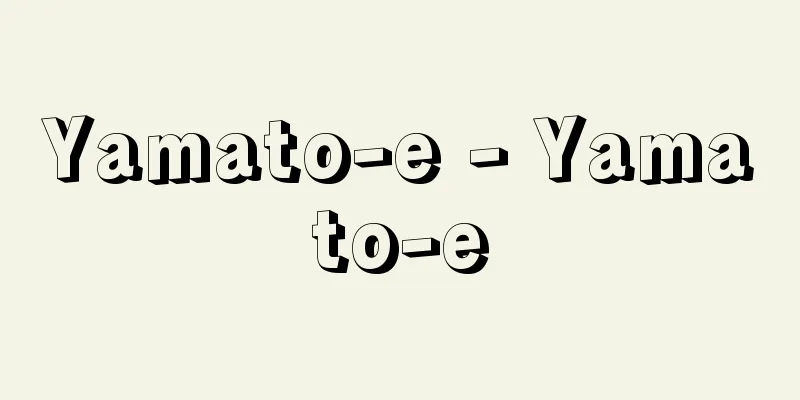Yamato-e - Yamato-e

|
It is also written as Wa-e, Yamato-e, or Wa-e. As one of the basic terms in the history of Japanese painting, it has been widely used from the Heian period to the present, but its concept has changed in several stages historically. In the Heian period, it was used to refer to paintings depicting Japanese landscapes and customs, especially folding screen paintings such as Tsukinami-e and Meisho-e, as opposed to Kara-e, which dealt with Chinese themes. In other words, the original meaning of the word was to distinguish between themes and did not include a stylistic concept. However, from the late Kamakura period, when the import of Song and Yuan paintings became popular, these Chinese paintings were called Kara-e, and the term Kara-e was also used to refer to new styles of Japanese painting influenced by them, especially ink painting. Then, the content of the opposing concept, "Yamato-e," also changed and expanded, and it came to broadly mean traditional genre paintings and landscape paintings from the Heian period onwards. From the Muromachi period onwards, this kind of traditional painting was passed down to the imperial court's painting studios, especially to the Tosa family (→ Tosa school), and as it came into conflict with Zen-based ink painters and the Kano school, which aimed to fuse Japanese and Chinese art, Yamato-e became a stylistic concept with a school-like significance. In the Edo period, it was passed down to painters of the Sumiyoshi school and the revival of Yamato-e, and became one of the foundations for the creation of new Japanese paintings after the Meiji period. Source: Encyclopaedia Britannica Concise Encyclopedia About Encyclopaedia Britannica Concise Encyclopedia Information |
|
倭絵,大和絵,和絵とも書く。日本絵画史における基本的用語の一つとして,平安時代以来現在まで広く用いられたが,その概念は歴史的に何段階かに変化した。平安時代には,中国的な主題を扱った唐絵 (からえ) に対するものとして,日本の風景や風俗を描いた絵,特に月次絵 (つきなみえ) ,名所絵などの屏風障子絵に対して用いられた。すなわち当初の語義は主題上の区別であり,様式的な概念は含まれていなかった。しかし鎌倉時代後期から宋元絵画の舶載が盛んになると,これらの中国画を唐絵と呼び,さらにその影響を受けた新様式の日本画,特に水墨画に対しても唐絵の語が用いられた。すると反対概念である「やまと絵」も内容を変化拡大させ,平安時代以来の伝統的な風俗画や風景画を広く意味するようになった。室町時代以降この種の伝統的絵画は宮廷の絵所 (えどころ) ,ことに土佐家 (→土佐派 ) の人々によって世襲され,禅林を中心とする水墨画家や,和漢融合を意図する狩野派と対立するに及んで,やまと絵は流派的意義を含んだ様式概念となった。江戸時代においては住吉派や復古やまと絵の画家などにも継承され,明治以後新しい日本画を生む基盤の一つとなった。
出典 ブリタニカ国際大百科事典 小項目事典ブリタニカ国際大百科事典 小項目事典について 情報 |
Recommend
Tomotoki Iseki
?-? A Japanese mathematician in the early Edo per...
Analytical Function Theory
...It expresses a deep faith in the idea that eve...
Silver thread fish
...The flower stalks that shoot up in early sprin...
Hydra (English spelling)
A general term for species belonging to the genus ...
Dirae
…Their number was at first indeterminate, but was...
Keisuke Kinoshita
Film director. Born in Shizuoka Prefecture. Gradu...
Iwata belt
A belly band worn by pregnant women. The term Iwa...
One million towers - Hyakumanto
〘Noun〙 One of the memorial towers. A small wooden ...
Geriatric psychiatry
A branch of psychiatry that studies various mental...
Abicebron - Abicebron
…Jewish poet and philosopher, born in Malaga, And...
Marlin drift net - Marlin drift net
...There are various drift net fisheries for flyi...
Oscan language - Oskan (English spelling)
An extinct language belonging to the Italic branch...
"Revenge of Haruhi Sumiyoshi" - The Vengeful Haruhi Sumiyoshi
...From January 11 of the following year, Tenno-c...
Bombyliidae
…A general term for insects belonging to the fami...
Naosumi Kagazume
Year of death: 1685 Year of birth: 15th year of th...









